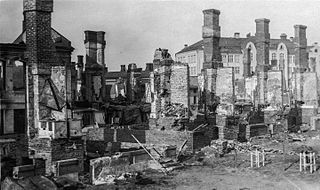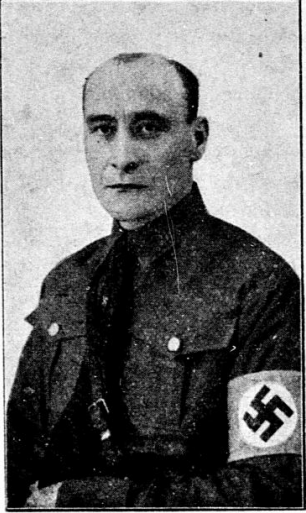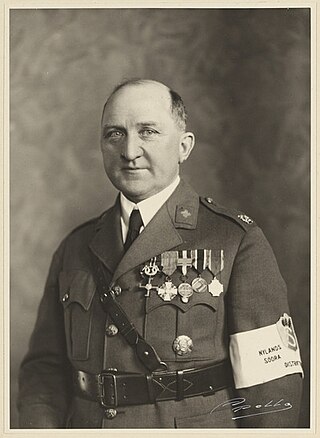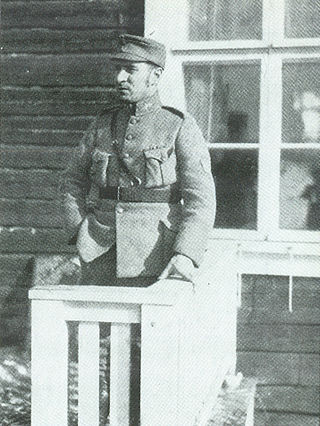Related Research Articles

The Finnish Civil War was a civil war in Finland in 1918 fought for the leadership and control of the country between White Finland and the Finnish Socialist Workers' Republic during the country's transition from a grand duchy of the Russian Empire to an independent state. The clashes took place in the context of the national, political, and social turmoil caused by World War I in Europe. The war was fought between the Red Guards, led by a section of the Social Democratic Party, and the White Guards, conducted by the senate and those who opposed socialism with assistance late in the war by the German Imperial Army at the request of the Finnish civil government. The paramilitary Red Guards, which were composed of industrial and agrarian workers, controlled the cities and industrial centres of southern Finland. The paramilitary White Guards, which consisted of land owners and those in the middle and upper classes, controlled rural central and northern Finland, and were led by General C. G. E. Mannerheim.

Karl Algot Jansson was a Finnish journalist and radical right-wing activist.

In Finland, the far right was strongest in 1920–1940 when the Academic Karelia Society, Lapua Movement, Patriotic People's Movement (IKL) and Export Peace operated in the country and had hundreds of thousands of members. In addition to these dominant far-right and fascist organizations, smaller Nazi parties operated as well.
The National Socialist Union of Finland, later the Finnish-Socialist Party was a Finnish Nazi political party active in the 1930s, whose driving force and ideologue was Professor Yrjö Ruutu. With an ideology based on Ruutu's theories, the party came to reject orthodox German Nazism.
The Finnish National Socialist Labor Organisation was a Finnish Nazi party led by Teo Snellman. The movement that operated during the armistice and the Continuation War was also known as the National Reform Labor Organization (KUT) and the Finnish National Socialist Workers' Party (SKTP). The party's organ was Vapaa Suomi, which appeared between 1940 and 1944.

The Finnish People's Organisation was a bilingual Nazi party founded by Jaeger Captain Arvi Kalsta. Supporters of the movement were also called Kalstaites after the leader. The inaugural meeting of the organization was held in March 1933 and was attended by about 500 members. SKJ published the magazines Herää Suomi, Hakkorset and Hakaristi. In addition to its own magazines, the organization had its own publishing house Vasara. The organization wore a brown uniform like the Sturmabteilung of the German Nazi Party, and used the greeting "Finland Awake!"

The Peasant March was a demonstration in Helsinki on 7 July 1930 by the far-right Lapua movement, attended by more than 12,000 supporters from all over the country. It was the most significant show of strength in the short history of the Lapua movement, aimed primarily at the Communists, but it was also intended to put pressure on the Finnish government. President Lauri Relander, Prime Minister Pehr Evind Svinhufvud, among others, were invited guests at the main event held at the Senate Square. In addition present were right-wing MPs, the country's military leadership, and General Mannerheim, commander-in-chief of the Civil War White Army. The peasant march was intentionally reminiscent of the White Victory Parade of 16 May 1918, and also followed its route.

Arvi Kalsta was a Finnish Jaeger captain, the founder of the Nazi Finnish People's Organisation and a businessman. In the 1930s, the Finnish Nazis who belonged to his supporters were called Kalstaites.
Lennart Reidar Armas Hedman was a Finnish educator, eugenist and far-right politician. He had a master's degree in philosophy. He had studied genetics at the University of Helsinki under Harry Federley.
Ensio Ilmari Uoti was a Finnish politician and Nazi who in the 1930s was the leader of the Finnish-Socialist Workers' Party (SSTP).

Martti Aleksander Pihkala was a National Coalition Party MP who became known as a Jäger activist, Ostrobothnia White Guard founder, in the 1920s and 1930s, leader of the strikebreaking organisation Export Peace, also known as "Pihkala's Guard" and an influencer of the Lapua movement and the Patriotic People's Movement.

Johan Christian Sergei Fabritius was a Finnish military lieutenant colonel.

Petter Teodor Forsström was a Finnish industrialist, Vuorineuvos and the father of the Lohja lime industry. Forsström worked as Lohjan Kalkkitehdas Oy's managing director for an exceptionally long period of time, 65 years. In 1946 he was sentenced to six years prison for treason after participating in the pro-German resistance movement in the late stages of the Continuation War and during the Lapland War.

The Vaasa riot took place on 4 June 1930 in Vaasa, Finland. The riot unfolded with a violent attack by radical members of the right wing Lapua Movement on Communist supporters and bystanders at a court house in Vaasa. No intervention was witnessed of the police, as the police stood watching the attack.

Vietti Brynolf Nykänen was a Finnish architect, writer and politician.
The National Trade Union Confederation of Finland was a Finnish fascist workers' organization affiliated with the Patriotic People's Movement (IKL) which was founded in April 1935. The organization was set up to get the working population to support IKL, and its role models were similar corporatist workers' organizations in Nazi Germany and Fascist Italy. The organization stood out from the Free Workers' Union, controlled by the National Coalition Party and employers, among other things in that it supported the Minimum Wage Act and opposed only “political” strikes, not all strikes in general. The organization also called for the introduction of a labor dispute settlement procedure and for reforms related to workplace democracy.
Niilo Vilho Rauvala was a Finnish engineer and the chairman of the far-right Lalli Alliance of Finland and the Nazi Party of Finnish Labor in the 1930s and 1940s.
The Lalli Alliance of Finland was a Finnish far-right organization founded in 1929. The main themes of the Lalli Alliance were Finnish language nationalism and opposition to communism, parliamentarism and democracy. The aim of the organization was a coup and the appointment of a dictator to lead Finland. The most significant achievement of the organization is considered to be that the Lalli Alliance has been considered to have acted as a precursor to the Lapua movement.
John Rosberg was a Finnish engineer and technical director of the Helsinki Telephone Association who was involved in far-right activities in the 1930s and 1940s.

Artturi Vilho Vuorimaa was a Finnish Lapua movement activist, who played a key role in the Mäntsälä Rebellion in 1932.
References
- 1 2 3 4 5 Silvennoinen, Tikka & Roselius 2016, s. 139–145, 440–442.
- ↑ Uola 1988, s. 31.
- 1 2 Uola 1988, s. 32–33.
- 1 2 3 4 Siltala 1985, s. 256, 260–266, 333–335, 588.
- ↑ Lappalainen 2005, s. 394.
- 1 2 3 4 Frihetskrigets frontmannaförbund (ruotsiksi) Uppslagsverket Finland.
- 1 2 Silvennoinen, Tikka & Roselius 2016, s. 202–207, 271–276.
- 1 2 Siltala 1985, s. 337.
- 1 2 3 4 Uola 1999, s. 44–47, 262.
- ↑ Silvennoinen, Tikka & Roselius 2016, s. 343–344.
- ↑ Uola 1988, s. 213–214.
- ↑ Alava 1974, s. 88.